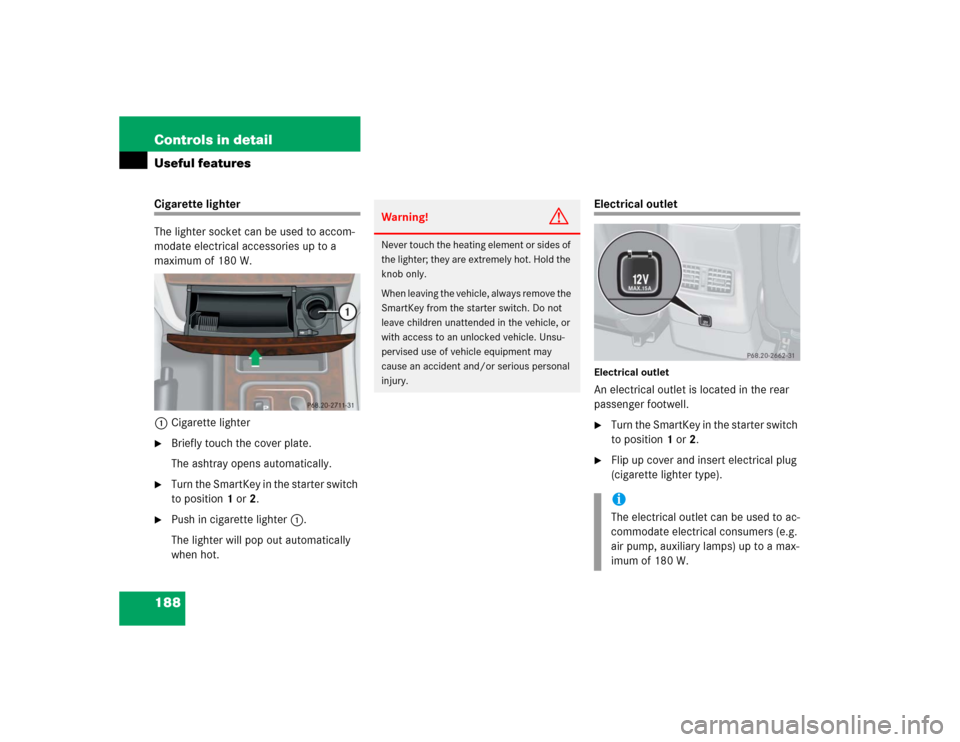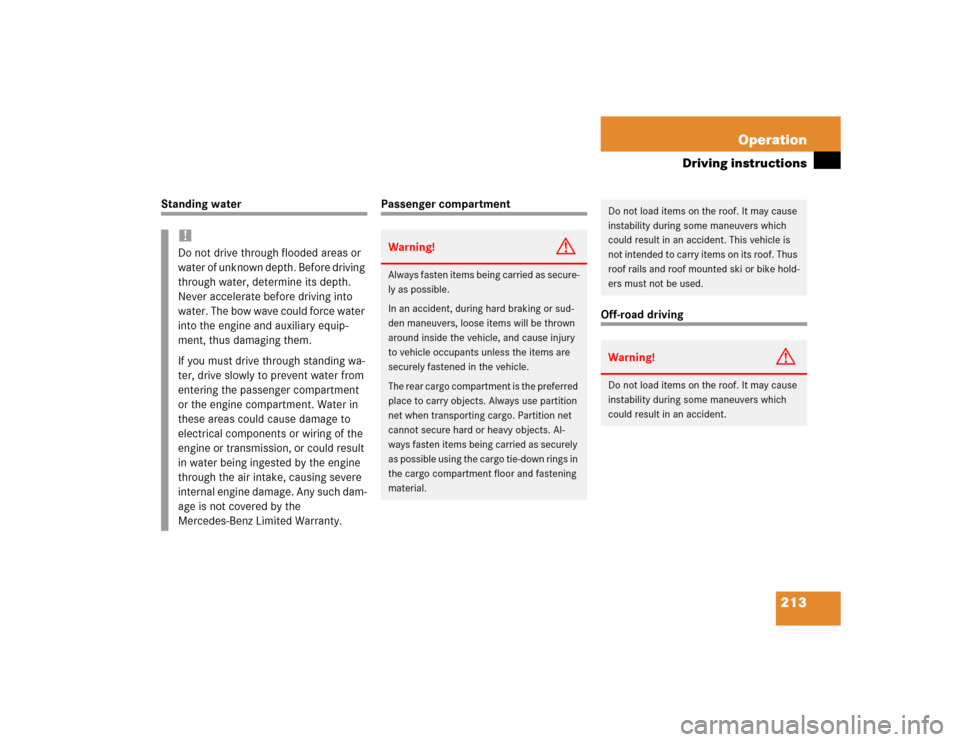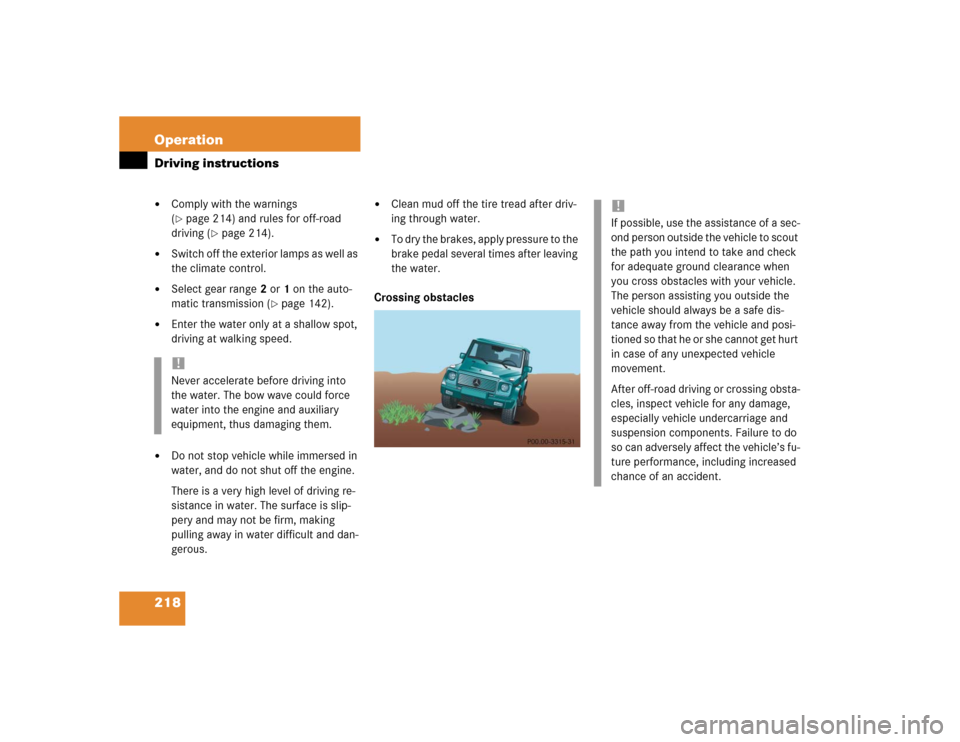Page 188 of 376

188 Controls in detailUseful featuresCigarette lighter
The lighter socket can be used to accom-
modate electrical accessories up to a
maximum of 180 W.
1Cigarette lighter�
Briefly touch the cover plate.
The ashtray opens automatically.
�
Turn the SmartKey in the starter switch
to position1 or2.
�
Push in cigarette lighter1.
The lighter will pop out automatically
when hot.
Electrical outletElectrical outletAn electrical outlet is located in the rear
passenger footwell.�
Turn the SmartKey in the starter switch
to position1 or2.
�
Flip up cover and insert electrical plug
(cigarette lighter type).
Warning!
G
Never touch the heating element or sides of
the lighter; they are extremely hot. Hold the
knob only.
When leaving the vehicle, always remove the
SmartKey from the starter switch. Do not
leave children unattended in the vehicle, or
with access to an unlocked vehicle. Unsu-
pervised use of vehicle equipment may
cause an accident and/or serious personal
injury.
iThe electrical outlet can be used to ac-
commodate electrical consumers (e.g.
air pump, auxiliary lamps) up to a max-
imum of 180 W.
N
Page 213 of 376

213 Operation
Driving instructions
Standing water
Passenger compartment
Off-road driving
!Do not drive through flooded areas or
water of unknown depth. Before driving
through water, determine its depth.
Never accelerate before driving into
water. The bow wave could force water
into the engine and auxiliary equip-
ment, thus damaging them.
If you must drive through standing wa-
ter, drive slowly to prevent water from
entering the passenger compartment
or the engine compartment. Water in
these areas could cause damage to
electrical components or wiring of the
engine or transmission, or could result
in water being ingested by the engine
through the air intake, causing severe
internal engine damage. Any such dam-
age is not covered by the
Mercedes-Benz Limited Warranty.
Warning!
G
Always fasten items being carried as secure-
ly as possible.
In an accident, during hard braking or sud-
den maneuvers, loose items will be thrown
around inside the vehicle, and cause injury
to vehicle occupants unless the items are
securely fastened in the vehicle.
The rear cargo compartment is the preferred
place to carry objects. Always use partition
net when transporting cargo. Partition net
cannot secure hard or heavy objects. Al-
ways fasten items being carried as securely
as possible using the cargo tie-down rings in
the cargo compartment floor and fastening
material.
Do not load items on the roof. It may cause
instability during some maneuvers which
could result in an accident. This vehicle is
not intended to carry items on its roof. Thus
roof rails and roof mounted ski or bike hold-
ers must not be used.Warning!
G
Do not load items on the roof. It may cause
instability during some maneuvers which
could result in an accident.
Page 218 of 376

218 OperationDriving instructions�
Comply with the warnings
(�page 214) and rules for off-road
driving (
�page 214).
�
Switch off the exterior lamps as well as
the climate control.
�
Select gear range2 or1 on the auto-
matic transmission (
�page 142).
�
Enter the water only at a shallow spot,
driving at walking speed.
�
Do not stop vehicle while immersed in
water, and do not shut off the engine.
There is a very high level of driving re-
sistance in water. The surface is slip-
pery and may not be firm, making
pulling away in water difficult and dan-
gerous.
�
Clean mud off the tire tread after driv-
ing through water.
�
To dry the brakes, apply pressure to the
brake pedal several times after leaving
the water.
Crossing obstacles
!Never accelerate before driving into
the water. The bow wave could force
water into the engine and auxiliary
equipment, thus damaging them.
!If possible, use the assistance of a sec-
ond person outside the vehicle to scout
the path you intend to take and check
for adequate ground clearance when
you cross obstacles with your vehicle.
The person assisting you outside the
vehicle should always be a safe dis-
tance away from the vehicle and posi-
tioned so that he or she cannot get hurt
in case of any unexpected vehicle
movement.
After off-road driving or crossing obsta-
cles, inspect vehicle for any damage,
especially vehicle undercarriage and
suspension components. Failure to do
so can adversely affect the vehicle’s fu-
ture performance, including increased
chance of an accident.